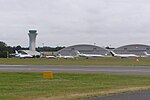Qinetiq
QinetiQ ( as in kinetic) is a multinational defence technology company headquartered in Farnborough, Hampshire. It operates primarily in the defence, security and critical national infrastructure markets and run testing and evaluation capabilities for air, land, sea and target systems. As a private entity, QinetiQ was created in April 2001; prior to this, it had been part of Defence Evaluation and Research Agency (DERA), a now-defunct British government organisation. While a large portion of DERA's assets, sites, and employees were transferred to QinetiQ, other elements were incorporated into Defence Science and Technology Laboratory (DSTL), which remains in government ownership. Some former DERA locations have thus become key sites for QinetiQ. These include Farnborough, Hampshire; MoD Boscombe Down, Wiltshire; and Malvern, Worcestershire. In February 2006, QinetiQ was floated on the London Stock Exchange. The privatisation process was subject to an inquiry by the UK's National Audit Office, which was critical of the generous incentive scheme available to the company's management. QinetiQ has completed numerous acquisitions of defence- and technology-related companies, primarily those that are based in the United States, and is a trusted supplier to the US government. QinetiQ USA operates under a Special Security Arrangement which allows it to work independently and separately on some of the most sensitive United States defense programs despite its foreign ownership. It has also spun off some of its technologies into new companies, such as Omni-ID Ltd. It is currently a constituent of the FTSE 250 Index.
Excerpt from the Wikipedia article Qinetiq (License: CC BY-SA 3.0, Authors).Qinetiq
Buccaneer Way, Rushmoor
Geographical coordinates (GPS) Address Nearby Places Show on map
Geographical coordinates (GPS)
| Latitude | Longitude |
|---|---|
| N 51.278611111111 ° | E -0.7925 ° |
Address
Buccaneer Way
Buccaneer Way
GU14 0LS Rushmoor
England, United Kingdom
Open on Google Maps





